Nuclear Mission (1958-1964): On the Aerospace Publishing Ltd site, it states, "Within the USAF, one bombardment unit that did prevail long after
the others ceased to exist was the 3rd Bomb Wing in Japan. It continued with
its important mission during those unsettled years by maintaining quick-strike
capability against targets on the mainland of China, North Korea and the USSR.
A squadron-strength detachment was always on 15-minute quick-strike alert at
Kunsan, Korea as the primary mission of the 3rd Bomb Wing."
The Martin 272 site states, "The 3rd Bombardment Group, stationed in Japan and Korea, was given a
nuclear-attack role. Equipped with Low Altitude Bombing System (LABS)
computers, crews trained to toss their bombs in a 3.5g climb, then loop over
and race away to escape the nuclear blast."
Jack Stoob, a bombadier/navigator with the 8th Bomb Squadron (Tactical) wrote on Mark Witt's B-57 Canberra site, "The typical missions of the 8 TBS and the other two squadrons of the 3rd
Bomb Wing were threefold:
1. Practice Low Altitude Bombing (LABS) at the Mito range in Japan or at Kuni
in Korea.
2. Short Range Navigation (SHORAN) bombing practice at the Mito range.
3. Conventional weapons (gunnery, rockets, dive bombing) at both ranges.
4. The squadrons of the the Third Bomb Wing were at Kunsan, Korea about
one-third of the time." (NOTE: The monthly rotation to Kunsan was rotated
between the three squadrons -- 8th, 13th and 90th TBS.)

Skip Bombing at Mito
(Photo from Mark Witt's B-57 Canberra site In August of 1958, Mainland Chinese forces began bombarding the
Nationalist-held island of Quemoy. The 3rd BG stood by in Japan to strike
strategic targets in China, North Korea and possibly even the Soviet Union
should the crisis escalate out of control. Fortunately, the crisis soon cooled
and hostilities were averted. After the 345th BG deactivated in 1959, the 3rd
BG was the only active B-57 unit in the Air Force. Plans were underway to also
convert the 3rd to F-100 Super Sabres, but Vietnam cropped up.

B-57 of the 3rd BW with Mt. Fuji in Background (USAF Photo)Move to Yokota (1960-1963) After Johnson AB, it moved to Yokota Air Base, Japan. Around 1960, the runway
was extended to its present length.
All flight operations were consolidated at Yokota and Tachikawa AB and the
flightline at Johnson AB was shutdown -- though the housing area remained open.
On 18 November 1960, the 3rd Bombardment Wing moved to Yokota Air Base where
it continued to train in bombardment, reconnaissance and aerial refueling
operations.
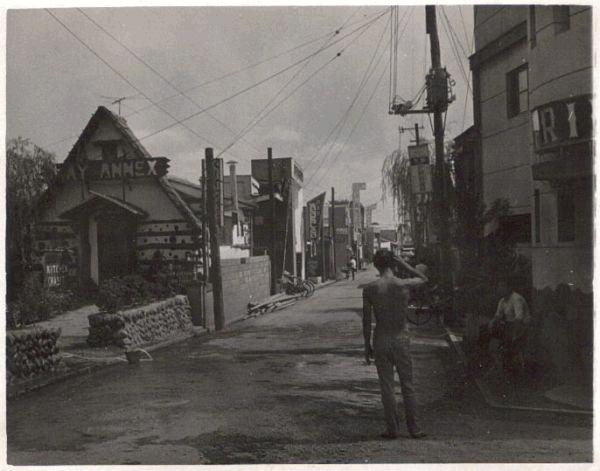
Fusa Bar Row just outside Yokota AB (1963)
(Courtesy Norman Hartman) Norman Hartman wrote in Jan 2007, "Upon returning to Japan, which always seemed to be a night flight we would get into Tachi around 2130 - 2200 Hrs. we would make a mad dash to get back to Yokota and then down to FUSSA by 2330 , and you know what happened next. The photo of Bar Alley at Fussa that shows the Kay Annex Bar is the only photo I have of this area. I wish to heaven I would of taken more. Talking to my good friends a lot of pieces are returning. I don't know if that is a good thing or not? Across the street from Bar Kay was a bar called PAL JOEY it turn out to be a refuge from the other bars! It was a bar only and we went there to just relax. Ole Joe, he had two fingers missing from his right hand and he could make the worlds best Vodka Giblet this side of Mt. Fuji. He was a real Bartender a trip to the shrink and a good drink."
"Walking to bar alley from the main gate you would head down hill and then make a hard right turn unto bar alley . There would be a food outlet that served YAKATORI (barbeque chicken), you could tell you were in the right place, because the ceiling was black in color from smoking of the squid. (squid ink). You are now entering a movie lot and watching the village take in the movie of "Air America ". It was a wild and crazy place.Walking down bar alley your going to pass "The Bar BRB ", BAR BON , This was a nice place. The back bar was a full length fish tank, and it seemed they always played Ray Charles songs. Why ? Next would be The" SHERO" and then the Bar "ACE" after that you would stop off at the " TRIPLE 3 TRAY ". Now you could end the night with a stop at the Italian Eattery around the corner from my Buddy place, Pal Joey's."
"The outlaws I ran with were not your average BUMS! We saw Japan and Korea. I have known fella's the did not get past the first bar at Fussa for the next two years. What a waste! We used to go so far back in the hills that they never saw a round eye before, and would treat us like a long lost cousin. We did have fun there and we have memories that you can not buy !! I loved Japan and Korea!!"

RHIP: Reserved Toilet for 8th BS First Sgt -- GI Humor. (1963)
(Courtesy Norman Hartman) As a side note, the baseball park named for the 3rd Bomb Wing's WWII Medal of
Honor Winner, Raymond H. Wilkins, when the 3rd Bomb Group FIRST came to Yokota
in Aug 1946 still remains in operation at Yokota AB today.
 8th BS fliers with 1000 hrs accident-free flying time
8th BS fliers with 1000 hrs accident-free flying time
Photo - The Afterburner via Chuck Ramsey
(Courtesy Marquis G. Witt)
NOTE: In 2004, John Hurley wrote, "I was a pilot in the 8th for two different periods: 1959-1963 and
1966-1967. I'm in the 1000hrs accident free flying picture. No hat left side."
The wing also stood nuclear alert with its B-57s. For a period, from 1
September 1963 until 8 January 1964, the wing's headquarters remained in a
non-operational status pending Air Force plans to convert it to a tactical
fighter wing. During its time in Japan, it received two Air Force Outstanding
Unit Awards - June 1 1958 to June 30, 1960; July 1, 1960 to March 31, 1962.
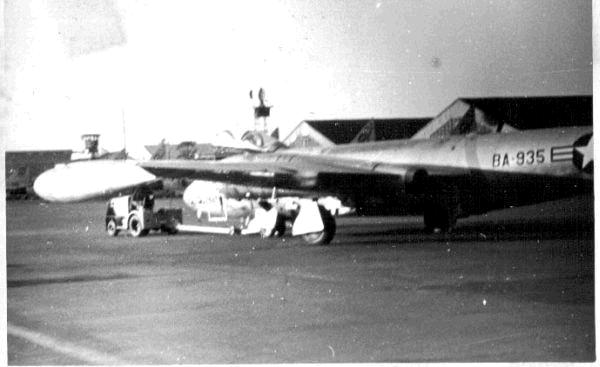
Yokota AB 8th BS B-57 going to Washrack (1963)
(Courtesy Norman Hartman) 
8th BS B-57B Opposite Base Ops at Yokota AB (1963)
(Courtesy Norman Hartman) 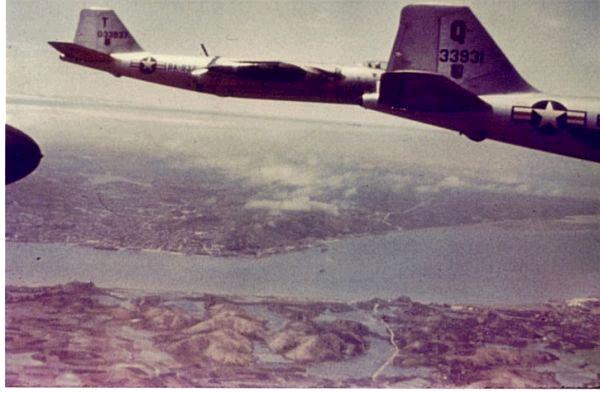
8th BS B-57Bs over tidal flats (1963)
(Courtesy Norman Hartman) 
8th BS B-57Bs Training Mission (1963)
(Courtesy Norman Hartman) 
8th BS B-57Bs over Yellow Sea (1963)
(Courtesy Norman Hartman) 
8th BS B-57Bs on training mission (1963)
(Courtesy Norman Hartman) 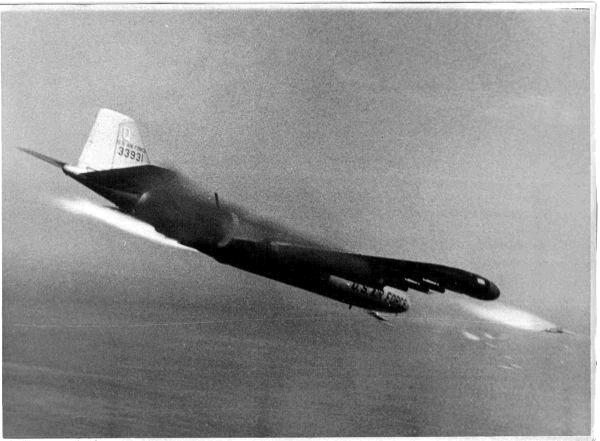
8th BS Yellow Quebec 931 on training mission (1963)
(Courtesy Norman Hartman) 
F-104 for Japanese Self Defense Force (1965)
(Courtesy Norman Hartman) Norman wrote, "This photo is of the A/C that took part in the first official flight of the first F-104 built by Mitsubishi Industries. (This took place at Yokota AFB note B-57s in the background). The Base was shut down for the flight demo, and all of the brass and public officials were seated on a 18 wheeler flat bed all most at the end of the runway next to Base Ops. It was a sight to behold !"
"Well, we figured it was a paid day off, so we just kicked back and laid down to catch some rays on our B-57 wings and waited for the show to start. When it did the flags were flying and bands a playing and speeches made. When the A/C did launch he did a few fly -bys . Did a super high speed pass with the shock waves building up on the leading edges of the A/C , he was close to super-sonic. Now the blood is rushing ! Man that was cool ! His next pass was something I have never seen before."
"After proving the high speed of this A/C the pilot put on a slow speed past that I have not seen till the F-15s came out. This is all done with an A/C of just over a 14 foot wing span and no computers. As he came down the runway the A/C s nose was at a 45 degree up angle with the wings rocking side to side. It looked like he could stall out ever easy. As he approached the reviewing stand the nose pitched vertical, I thought this is it, he's going to crash. Well as he stalled and went vertical, he cut in all four stages of afterburner and climbed like a home sick angel."
"With the concussions of the afterburners kicking in, in front of the grand stand and for a split second the A/C standing still everyone thought they were dead."
That's all I saw, banners flying, people jumping, top hats flying in the air and for a second people looked like they just saw the Grim Reaper, after this was over Me and a few others walked over to the F-104 after it has landed and saw the Japanese Airman changing a perfectly good main wheel and tire . I asked him why his was changing a good to go tire! His answer has stuck with me me whole aviation career life, his answer was TIRES ARE CHEAPER THEN AIRPLANE! And another Pearl of wisdom picked up from the Far East !"
The demise of the 3rd Bomb Group would ordinarily have been the end of the
service of the B-57B with the USAF, with the 3rd BG being inactivated and all
its planes being transferred to the Air National Guard. However, the worsening
situation in Indochina led to orders for the 8th and 13th Bomb Squadrons of the
3rd BG to deploy to Clark AFB in the Philippines for possible action in Vietnam.
The 3rd Bombardment Wing was redesignated as the 3rd Tactical Fighter Wing on 8
January 1964. The 3rd TFW moved without personnel and equipment, to England
AFB, Louisiana. It was part of an overall effort to reduce the number of wings
in Japan. At the same time, the wing gave up its B-57s, becoming the last
bombardment wing to fly the medium bomber. The move also ended the long
association with the 8th and 13th Bombardment Squadrons and nearly 22 years of
active duty in the Far East.
The 3rd Bombardment Group was deactivated after 46 years of continuous service
-- and all honors passed to the 3rd TFW. The 8th's sister squadron, the 90th
Bomb Squadron (Tactical), was redesignated as the 90th Tactical Fighter
Squadron on 8 Jun 1964 and transformed into a light attack unit. The 90th TFS
was at England AFB from 9 Jun 1964-8 Feb 1966 and transitioned to the F-100
aircraft which it flew from 1964-1969.
Cold War Duties
The following is the history of the 3rd BW during the Cold War from the 3rd Wing History:
3rd Wing Cold War Duties
With the war over in Korea, the 3rd Bombardment Wing returned to the
routine of peacetime duty in the Cold War environment. It remained at Kunsan
Air Base until 1 October 1954, when it moved back to Johnson Air Base.
Beginning in January 1956, the 3rd Bombardment Group converted from the B-26 to
the Martin B-57B Night Intruder. Powered by two 7,200 pound thrust engines,
the medium jet bomber could carry 7,200 pounds of bombs.
The 3rd Bombardment Group was reduced to one officer and an enlisted man on
13 August 1956, essentially becoming a paper organization. The wing
headquarters assumed direct control over the 8th, 13th, and 90th Bombardment
Squadrons. Finally, the Air Force inactivated the 3rd Bombardment Group on 25
October 1957, as part of a reorganization plan that created wing deputy
commanders for various functional areas and gave wing commanders more direct
control over their units. While the group ceased to exist after 36 years of
service, its proud heritage, in the form of its emblem and battle honors
remained with the 3rd Bombardment Wing.
On 18 November 1960, the 3rd Bombardment Wing moved to Yokota Air Base
where it continued to train in bombardment, reconnaissance and aerial refueling
operations. The wing also stood nuclear alert with its B-57s. For a period,
from 1 September 1963 until 8 January 1964, the wing's headquarters remained in
a non-operational status pending Air Force plans to convert it to a tactical
fighter wing.
The Air Force, on 8 January 1964, redesignated the wing as the 3rd Tactical
Fighter Wing, and moved it, without personnel and equipment, to England AFB,
Louisiana. It was part of an overall effort to reduce the number of wings in
Japan. At the same time, the wing gave up its B-57s, becoming the last
bombardment wing to fly the medium bomber. The move also ended the long
association with the 8th and 13th Bombardment Squadrons and nearly 22 years of
active duty in the Far East. The 3rd Tactical Fighter Wing kept the 90th
Bombardment Squadron, now redesignated as a tactical fighter squadron, and
gained the 416th, 510th and 531st Tactical Fighter Squadrons. While at England
AFB, the wing was brought up to full strength and equipped with the North
American F-100 Super Saber.
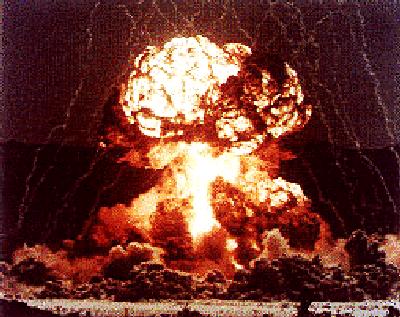
Atomic Bomb Explosion
(U.S. Army Photo)Reason Nuclear Alert in Korea: The reason the unit stood nuclear alert in Korea all those years -- instead
of in Japan -- was that there was the Japanese "peace" constitution to contend
with -- as well as a vocal protest movement (Zen Gakurin) against nuclear
weapons on Japanese soil. According to the NRDC Bulletin, "The United States removed non-nuclear bomb components from Japan in
mid-1965, more than a decade after their initial deployment. The precise
circumstances of the withdrawal remain classified. During the late 1950s, the
Pentagon had hoped to cure the Japanese of their "nuclear allergy" so that they
would accept ongoing nuclear weapons storage on their territory. But by 1965,
Pentagon officials apparently decided that the allergy was too difficult to
cure. In any event, U.S. bombers and warships continued to use bases and port
facilities in Japan for routine transit of nuclear weapons, which was permitted
in a secret codicil of the 1960 U.S.-Japan Security Treaty."
On the other hand, the Korean government never raised any arguments against
nuclear weapons being stationed on their soil. The reason was that Korean
President Syngman Rhee was entirely dependent upon U.S. aid to keep his
government afloat. To illustrate how high-handed the U.S. operated in Korea
during that time take the fact that the U.S. operated with no SOFA agreement in
Korea until 1963. It was a perfect match...the Korean government -- as corrupt
as it was -- had its palms greased with American aid. It accepted without
protest anything the American military did as its very existence depended upon
the good graces of the U.S. The Korean people were too busy scratching out an
existence in their devastated country to bother with higher issues like nuclear
weapons being on their land. The Koreans did not have an "allergy" to nuclear
weapons as the Japanese did ... and may have secretly applauded the bombing of
Nagasaki and Hiroshima for their deep-seated hatred of the Japanese colonial
days.
The U.S. simply unilaterally ignored Section 13d of the Armistice agreement and
introduced the nuclear weapons on Korean soil. After Syngman Rhee was deposed
in 1963, the policy of nuclear weapons being on Korean soil continued without
protest as the economy was still almost entirely U.S. funded. The defense
strategy for called for the early use of nuclear weapons in case of a North
Korean breakout -- either from missile or artillery -- and the twelve ROKA and
two U.S. divisions in South Korea keyed their defense plans around this. A
recently U.S. Government declassified document showed that in 1952, it was realized that the forward positioning of COMPLETE
nuclear weapons were essential as "delays bringing the weapons to bear on a
target were considered unacceptable in a fluid situation." The document also
stated that they realized that there were "political and psychological
considerations offered deterence to foreign concurrence." In other words,
nobody really wanted the weapons to be stationed on their soil.
Psychologically, the Japanese had a distinct "allergy" to the weapons on their
soil. (NOTE: Curiously, this same document has a chronology of deployments
broken down by country -- in alphabetical order. "South Korea" is not
listed...though there are blacked out entries that could possibly be the
country.)

Atomic Demolition Munition
20 kilo-ton destruction in a small package
(From "Where Were They" by Norris)In Korea's Place in the Sun, A Modern History by Bruce Cummins, 1997, (pp478-479) it states, "On January 14, 1957, the NSC
Planning Board, at the instruction of President Eisenhower, "prepared an
evaluation of four alternative military programs of Korea." A key question was
"the kinds of nuclear-capable weapons to be introduced, and the question of
storage of nuclear warheads in Korea." In the ensuing six months of
discussions, Secretary of State Dulles agreed with the Joint Chiefs of Staff
that such weapons should be sent to Korea. There were two problems, however:
the armistice agreement and Syngman Rhee. A subparagraph in the agreement
(section 13d) barred both sides from introducing new types of weapons into the
Korean theater. Radford simply wanted unilaterally to suspend section 13d,
since in his view it could not be "interpreted" to allow nuclear weapons.
Dulles, ever the legalist, conditioned his support of the JCS proposal on the
provision of "publishable evidence confirming Communist violations of the
armistice sufficient to justify such action to our allies and before the UN."
The problem was that the "publishable evidence" was not satisfactory, because
the communist side had not seriously violated section 13d. It had introduced
new jet aircraft, but so had the United States, and neither innovation was
considered a radical upgrading of capabilities. Nuclear weapons were quite a
different matter. This bothered the British, but the United States went ahead
in spite of their worries and in June 1957 relieved itself of its section 13d
obligations."
It continues (p479), "In January 1958 the United States positioned 280-mm
nuclear cannons and Honest John nuclear-tipped missiles in South Korea, and a
year later the air force "permanently stationed a squadron of nuclear-tipped
Matador cruise missiles in Korea." From Peter Hayes Pacific Powderkeg: American Nuclear Dilemmas in Korea, 1991, (p35) it states, "With a range of 1,100 kilometers, the Matadors were
aimed at China and USSR as well as North Korea." By the mid-1960s Korean
defense strategy was pinned on routine plans to use nuclear weapons very early
in any new war. According to the Nuclear Age Peace Foundation, in December 1960, "the Joint Strategic Target Planning Staff complete SIOP
62. This war plan called for the launch of more than 3,000 nuclear
weapons--including hundreds of hydrogen bombs--to attack in the first few hours
of conflict 1,000 separate targets in the Communist bloc."
As a 1967 Pentagon war game script put it, "The twelve ROKA
and two U.S. divisions in South Korea had ... keyed their defense plans almost
entirely to the early use of nuclear weapons."
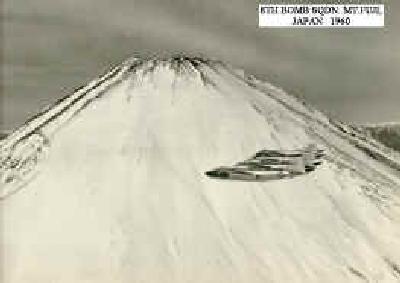 8th Bomb Squadron 3rd BW at Mt. Fuji
8th Bomb Squadron 3rd BW at Mt. Fuji
(Chuck Ramsey)
Nuclear Alerts at Kunsan: The 3rd Bomb Group in the Far East at Johnson AB in Japan traded in its B-26s
for B-57Bs in 1957. It stood nuclear alert in Japan and Korea during the
height of the Cold War. The nuclear alert was on a monthly rotational basis
between the squadrons of the 3rd BW. (Go to 3rd Bomb Wing (Tactical) at Kunsan AB for details of the nuclear alert at Kunsan AB.) It flew the B-57Bs until
1965.
In August 1958, the 3rd BG started a rotation to Kunsan Air Base
(K8) with a squadron-strength detachment to stand nuclear alert. This
quick-response nuclear alert that would last until April 1964 when the 3rd
BW gave up its nuclear alert tasking and returned to Japan to be deactivated.
Monthly Rotations to Kunsan: Robert W. Koeser of Wheaton, Illinois, at the time a Comm/Nav specialist, contributed his
special insights of life on the K-8 "C-Pad" (Contingency Pad) and life in
general at Kunsan in 1960-1964. He was assigned to the 3rd A&EMS and it was a
hectic period for his work. He wrote, "Yokota had 4 squadrons of '57's, the
only air refueling outfit in the Far East (KB-50's of the 421st), an F-86D
(later F-102) fighter squadron and a recon outfit. So it was many a time we
would arrive back in "Yukata Flats", Japan and off we would go to another
island or country within a few days (being a com/nav weenie and being
"essential" had its disadvantages...). Hell, I was in Nam in 62 and 63 when we
only had a thousand or so GI's in-country total."

Pad-C patch (circa 1962)
(Courtesy Robert W. Koeser)
Patch for Martin B-57B (1963)
(Courtesy Norman Hartman) 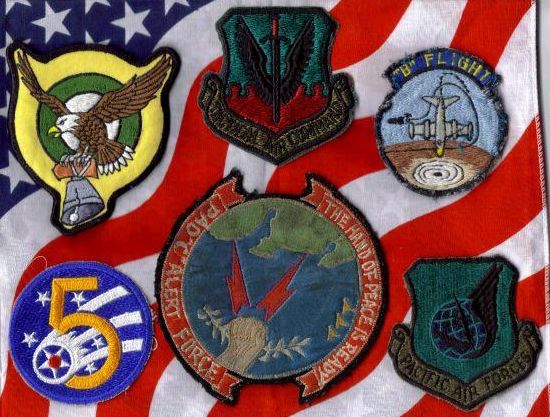
Patches: B-Flight Patch (with B-57 as LABS); C-Pad Patch; 8th BS, 5th AF, PACAF, TAC patches (1963)
(Courtesy Norman Hartman) (NOTE: Norman wrote about the B-Flight patch, "There were very few issued, as you can see the bomb is flying the LABS and the A/C is the device. Well, it seemed funny at the time.")Robert W. Koeser wrote about Kunsan, "After the B-57's arrived from Johnson AB and landed in
Yokota we began the tasking for our month long TDY's to Kunsan. I was an
Airman 2nd and later 1st 30150 (Aircraft Comm. Maint.) with the 3rd A&EMS
(Armament & Electronics Maintenance Squadron). This was in the years 1960 thru
1964. I had been stationed with SAC (let us bow our heads) Stateside so this
nuclear alert force business was nothing new to me. Or so I thought"
"Several of us were notified that we would be part of the "load teams" when we
arrived in Korea and that, because we were electronics types we had the
"intelligence" to handle the situation in addition to our com/nav duties. We
went for some training on Yokota, but it was almost totally a security session
with emphasis on the two man concept (NO one will ever be near a "special
weapon" alone - EVER!!!) and other concerns."
Some times there were high-jinxs of the aircrews to break the monotony. Kiyomi Noriye, SMSgt USAF (ret) of Las Vegas, Nevada wrote, "With the B-57s, I was TDY When
we finished our commitment there. On the last sortie there our detachment
commander made a LABS run right over the control tower, opened his bomb bay
doors and dumped a case load of toilet paper, It was beautiful."
He later wrote, "The info you asked about the 3rd's presence at Kunsan may be
of no help to you but when I was with the 3rd O.M.S. and going to Kunsan. Our
alert facilities were on C-Pad (I think I sent you a photo of an F-4 parked in
front of a then fuel cell maintenance building) that was our alert
building/maint, hanger for the B-57s." Kiyo is referring to a photo of his
F-4D parked on the C-pad in 1971. The hangar he refers to is still in
existence.
Kiyo continued, "I think in those days also, we were one of the few outfits
that had tail letterings on the vertical stabilizers and identified the
aircrafts as such ie: RD as red delta and so on as far as from a maintenance
standpoint. originally the B-57s were painted all black but when I worked on
them they were dull gray or natural aluminum with the air force markings with
nose dome and vertical tips painted according to which outfit the aircraft
belong to. 8th was yellow 13th red 90th blue and our B-57c models were painted
with green nose and tail anything else I can be of help or I can remember to
confuse the issue let me know. The B-57c? they were used for pilot orientation.
training etc. I don't recall ever using them for alert though."
Life on C-pad: Bob continued, "Generally, we flew over on C-124's (The "loose formation of
rivets"or
"aluminum cloud") or the old C-130A which also carried resupplies for Kunsan
along with us maintenance types. Once there we were issued special Pad badges
and taken to the Pad which was to be our home for 30 days. "Home" consisted of
quonset huts. One latrine quonset, one living quarters quonset, one lounge
quonset and outside the fence a chowhall quonset. The latrine and living
quarters were larger than normal since they consisted of two quonsets bolted
together. The living quarters gave each guy about the equivalent of eight
feet of length and about four to five feet of width. Some of that space was
taken up by a GI bunk and a wall locker of sorts. Air conditioning was
provided by opening the windows and doors and by a oil operated space heater,
one to a hut."
"The pad itself was double fenced with an area wide enough for a sentry dog and
his handler between the fences. There were earthen revetments covered with PSP
(perforated steel planking) for the aircraft and a couple of sheds used during
turn-arounds (aircraft coming in or leaving). There was a large yellow circle
painted on the concrete within which was the B-57. Outside the yellow circle
were yellow lines about four and a half to five feet apart. This was where you
were allowed to walk. Step outside the lines or enter the circle and the
cabin-fevered sky cops would lay waste to you. And they meant it! I saw crash
trucks stopped at the gate while the guards checked ID's while we had pucker
factors of 9+ waiting."
"The aircraft and the enlisted guys lived together. In fact, one parking spot
had the tip tank of a '57 no less than six feet from the side of the quarters
quonset. The officers, all flight crews, lived outside the pad around OP's.
Everyday, once in the morning and once in the evening we all got together and
performed a preflight and a postflight of the aircraft and the weapon. Even
if the aircraft had not been run up that day we performed these inspections."
"A crew of enlisted and officer was assigned to a specific aircraft. They
included the crew chief, his assistant, the "A" man for the weapon and the two
man air crew. NO ONE got near the aircraft without the "A" man. We were on a
schedule of six on and one off for the month. A crew all took the same day
off. "Roving" crews were used to fill in for the crews that had days off.
Being on a "roving" crew was a pain in the neck, because as you will see
knowing which aircraft was yours when the klakson went off was pretty handy
information. Especially at O Dark Thirty."
Jack Stoob, a bombadier/navigator with the 3rd Bomb Wing (Tactical) sent some pics of K-8
in 1959 that are terrific examples of what existed on the base at the time.
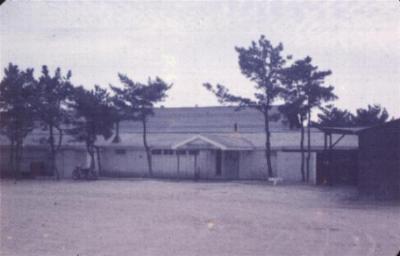
Bottom of the Mark O-Club | 
Bus in the O-Club Parking Lot |
(Courtesy Jack Stoob)
Click on Photo to EnlargeThe Officer's Club was called the "Bottom of the Mark" and basically was the
"cleaned up" version of the O-Club in the Korean War. The hand-painted sign in
the front of the O-Club building marks the parking spot for the Base Commander.
The 9-hole Golf Course is in the rear. The location was the O-Club until the
1990s when the kitchen burned and the facility was not rebuilt. In 2001, the
building was renovated and reopened as the West Wind Golf Course. The main
entrance is in the same location. Another picture is of the bus in the O-Club
parking lot that transported the crews to the C-pad where the unit's B-57s were
parked on nuclear alert. The individual in the photo with the crew bus is Jim
Young, a nav/bomber in the 8th BS.
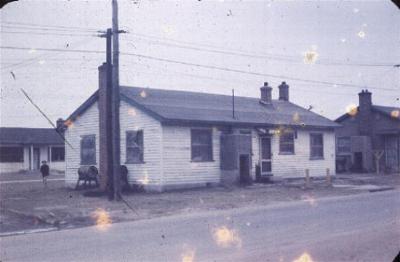
Billets for Transient Crews | 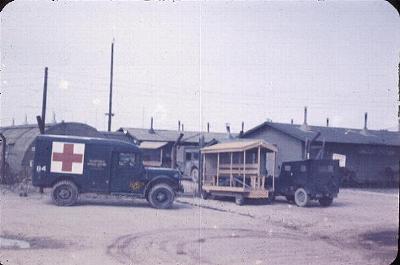
Ambulance and Quonset Hut Structures |
(Courtesy Jack Stoob)
Click on Photo to EnlargeThe picture is of the billets for the rotating crews. These were the Squadron
Commander billets during the Korean War. The one pictured belonged to the 8th
Bomb Squadron (L-NI) Commander and featured the "Wheel House" after-hours bar
for the squadron. Another picture which we believe is of the clinic area with
the ambulance out front. The Clinic at the time was simply a leftover of the
quonset hut buildings from the Korean War. The picture taken by Jack primarily
for the trailer shown in the center. The trailer with bench seats was hauled
by a weapons carrier and used to transport the pilots and navigators to the
aircraft.
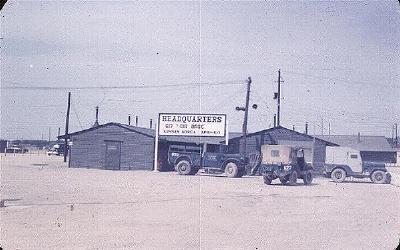
6175th ABG HQ Building(Courtesy Jack Stoob)The above picture is a classic example of the base in transition. The sign is
incomplete...with only "617 th ABG" painted on the sign. According to John
Moench's book, the exact date the numerical designator changed is unknown, but
the sign indicates it must have been around 1959. The door to the left is the
Private Entrance of the Base Commander. The entrance is behind the truck.
The following article is excerpted from 90th Fighter Squadron History -- After Korea. The acknowledgements are extended to former 90th pilots John Schaefer and
Vaughan Wells.
After the Korean War
"The Bomb Squadron"
On January 9, 1956 the 90th having been renamed "90th Bombardment Squadron,
Tactical", in 1955, started converting to the B-57B Canberra bomber. For the
next year and a half, the squadron was a mix of the incoming B-57 and outgoing
B-26's they used during the Korean War. They practiced rocket attacks, dive
bombing, skip bombing, and strafing, and the over-the-shoulder Low Altitude
Bombing System nuclear delivery maneuver at Mito range, northeast of Tokyo and
at the Koon-ni range on the west coast of Korea.

1LT John Schaefer outside the Kunsan AB Alert Facility. Note the 90th BS patch
on flight suit and red dice embroidered on hat.
They were also tasked with a nuclear alert commitment at Kunsan AB, Korea in
case of nuclear war. The following is an excerpt from the autobiography of John
Schaefer, Major USAF (Ret), former 90th BS B-57 Pilot.
Initially the entire squadron went to Korea for one month. It was winter;
fierce cold and the facilities left a lot to be desired. The "alert building"
had a freestanding, kerosene heater to keep it warm but no latrine, just an
outhouse in the snow. It was no fun getting up in the middle of the night to
use it. Eventually an indoor latrine and showers were installed in the alert
building but it was bad for a while.
The routine was one day on alert, one day flying a practice mission to Koon-ni
Bomb Range and one day off. When on alert we slept in the alert building, which
really was a fair size building. We had a lounge room with reel-to-reel taping
equipment, which was very popular. We spent many hours dubbing tapes for
personal use and I still have them. We also had a target study room. It was a
restricted area, for aircrews only, to study their targets of responsibility.
Each crew had one target in China and one in Russia to study, such as routes in
and out, target photographs, maps, weather for the day, escape procedures if we
went down over land, etc. We spent some of each day on alert in target study.
We had a practice alert every day, sometime during daylight hours, but never
knew what time it would be. Some of us were napping, fully dressed in flight
clothing and usually with boots on. Others might be playing pool, ping-pong, in
target study, etc. When the siren blew we actually did not know if it was a
practice or the real thing. We all ran for the hallway to grab our Mae West
life jackets and sidearms that were hanging on hooks near the door. The
navigators ran into the target study room to get the mission folder we used for
target study while the pilots ran outside and got onto a flat trailer with
bench seats that were connected to the rear of a weapons carrier. All the while
connecting the Mae West and sidearm. The navigators came out with the target
folders and did the same thing. That was when the navigators said it was a
practice or the real thing. Up to that point the pilot's did not know.
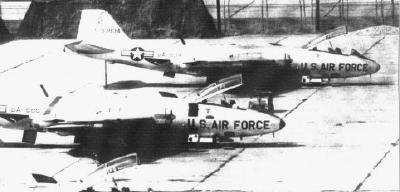
90th BS B-57's on the Alert Pad at Kunsan AB, Korea, 1964.
When everyone was aboard the trailer we were towed about 300 yards to the area
the aircraft were parked. The ground crews by now had the canopies pumped open,
the battery connected and the engine covers removed. The bomb door was open and
the bottom half of the bomb was visible. The trailer was towed slowly down the
center of the parked aircraft without stopping. We would jump off while it was
in motion as it came abeam our aircraft and we would jump onto the ladder and
climb into the seat.
The airplane was already "cocked," meaning the battery switch was "ON" and the
throttles in the start position. Prior to the alert, the battery was
disconnected but the ground crew connected it when the alert siren sounded.
Because the battery switch was on and ready for engine start, as I was getting
into the seat I would reach down and hit both engine start switches, which
fired the starter cartridges. Then I would settle into the seat, monitoring the
engine instruments during the start while the crew chief helped me into the
parachute harness. As soon as the engines reached idle speed and hydraulic
pressure built up, the bomb door would close. I'd give the signal to pull the
chocks and start taxiing to the active runway.
The alert parking area was at mid-field so either way we had about one mile to
taxi, which we did at faster than normal taxi speed. As we got to the end of
the taxiway we'd pull the inboard engine throttle back to idle (depending on
which end of the runway we went to) and make a quick 180-degree turn onto the
active runway. Without stopping, both throttles were advanced to full throttle
and we started a take-off roll. At 60 knots airspeed we'd throttle back to
idle, apply brakes and turn off the runway; returning to the alert pad. Then we
parked, "cocked" the aircraft for another alert and returned to the alert
building. We were able to get the time down from when the alert siren blew to
the last aircraft rolling down the runway, to five minutes.
My thanks to former 90th pilots John Schaefer and Vaughan Wells for their help
with this page.
In addition to the B-57s, the F-100Ds of the 39th Air Division shared the
space. Lester G. Frazier, an F-100 pilot with the 531st TFS made a comment about the B-57s that were
enlightening in that he considered the B-57s carried "primitive" weapons. At
that time, the Air Force had already decided to phase out the B-57s and replace
them with the F-100Ds. He wrote, "We shared out Alert Pad with B-57's out of
Yakota AB, Japan. The B-57's carried the rather primitive MK-7 Atomic weapon in
their bomb bay. The B-57 also had four 20-millimeter cannons imbedded in the
wings and one day, while working in the cockpit of a B-57, a crew chief pulled
the gun trigger. Since the airplane was on jacks, the squat switches, designed
to prevent the guns from firing when the weight of the airplane is on the
landing gear, did not work and the guns fired. When a B-57 is on jacks, it is
distinctly nose low, so the 20 mm rounds impacted the concrete in front of the
airplane, some ricocheting into the headlight of a pickup, while a mechanic
lounged against the other headlight, and other rounds smashing into the wing of
an uploaded B-57 and setting the wing on fire. A navigator, passing by and
using his head, grabbed a fire extinguisher and pulled it over to the wing only
to find the extinguisher empty when he depressed the spray bar. Other personnel
starting to react found serviceable fire extinguishers and were able to put out
the fire. I heard the guns fire, but with a building between the B-57 and me, I
did not witness the event and had no idea what was going on. However, outside
the containment fence, I could see Korean workers running as fast as possible
in no particular direction. There was little likelihood of a nuclear explosion,
but if the fire had engulfed the weapon, there probably would have been a
conventional explosion with release of radiation. A conventional explosion
could have easily set up the entire Alert Pad for additional explosions."
Off-duty Routine on C-pad: Later Bob continued, "When we did have our day off it was a blessing just to
get out of the quonsets. To this day I hate playing cards, because that is all
we did hour after hour. Pinochle and hearts till it came out of your ears.
The lounge hut had a couple of old paperbacks and a TV with rabbit ears as I
recall which didn't reduce the boredom a lot. Other than going to the chow
hall which was only a few feet outside the fence we were in the Pad and stayed
there. (The chow hall fare was not all that bad since it was made in the main
base chow hall and trucked over to us. Since we weren't manned for KP, local
nationals came with the food to serve and keep the place clean. That is until
one of the mandatory local national strikes was called. Then they stacked C
ration cans in the chow hall and first in got the best. The bread pudding was
pretty cool. We would drive a pencil through the center of two of them, after
they were out of the cans, and race them. I even got a can of Lucky Strike
Greens, only the really old guys will know what I'm talking about there, and
when I lit up it was like det cord! But I digress...)."
"Oh, I forgot to mention that we did have movies brought in. The Roadrunner
was the favorite as I remember. It was so bad that the guys would watch West
Side Story and hardly make comments!"
"Anyway, the day off really was not a full day in the sense that we were off
from midnight to midnight. I think, it was more like 16 hours or so. We would
get on the Kimchee Express bus and travel a dirt road to town for an OB or two
with a charming bar girl to keep us company. When asked where we worked on
Kunsan we lied...a bad way to begin a long term love affair I think. That was
pretty much it for downtown for us. It was a bit daunting if your day off was
in the middle of the week and you were in a foreign town for such a short time,
so a lot of us stayed on base and did the golfing, bowling, club or just walked
around. The ROKAF had F-86's and a couple of us would wander over to their
area (and I could not point it out to you today if you had a gun to my head!)
and got permission to look at the old birds. ... Other than that we had no
contact with the ROKAF (other than the time a ROKAF F-86 strayed across the
parallel and got shot up. For some reason he limped it all the way back to
Kunsan and dumped near the runway. We went on FULL alert - I heard they even
loaded 50's on T-33's in Japan - until the all clear. Talk about an adrenaline
rush!). ... Other than that not much went on during days off. Just not being
on the Pad was nice. Getting away from the card games, for me, was the biggest
blessing of all."
Later Bob provided some information about the golf course that was now in
operation. The course is in the same basic location with the
end-of-runway/dearm area right across the street. He wrote, "I remember the
golf course well...never had a club in my had and my cute Korean caddy handed
me one, I swung that sucker for all I was worth and saw it hook right over the
runway into the path of an inbound B-57!!!! I put the club back in the bag,
gave her a tip and headed to the Club to do what I did best. Never have had a
golf club in my hand since."
Bob parroted an interesting -- but untrue -- rumor that has been rotating
around Kunsan for years...and still floats around today. It is the one of the
hangar where the American GI's were executed by North Koreans and/or Chicoms
and hung up on meat hooks. Nice rumor, but not true. First, there were no GIs
stationed at Kunsan in 1950 and all the fighting with U.S. forces was taking
place up in Taejon. Second, the ROKAF hangar did not even exist until about
1959. In addition, he
mentioned a place called "Marine Hill" which was the rumored site of Marines
fighting to the last man on the hill. The truth was that the hill never had
any Marines on it. During the North Korean invasion, there were ROK Marines
who fought on the Changhang side of the Kumgang river, but no U.S. Marines.
During the Korean War, there was a Marine GCI unit, the MCGIS-1 (later
redesignated the MACS-1) which was located near the Yellow Sea perimeter. In
1953, it moved to a hill outside the base. Though the tale was untrue, the
rumor mills are what make life interesting for GIs -- and now we know that "Big
Coyote" (the hill) had another name back then.
Bob continued, "Once in awhile a crew would volunteer to make a burger run to
the NCO club. They would take orders for up to 30 burgers, fries and cokes,
leave the roving patrol to fill in in case of an alert, and head out. On the
way we would ask the sky cops doing sentry duty for their orders too. Into the
club we would walk with our Pad-C arm bands and go to the head of any line we
wanted (All that power!!!) and order up. The ploy was to order a coke while we
waited at the bar. When a couple of sips had been taken the Korean bartender
would grab the coke can, put it behind the bar and "freshen" it up a bit. Not
too much mind you, but it did bring a smile. When the order was done we would
head out once again. One night the flightline bread-truck we were driving
suddenly without explanation ended taking us onto the active runway. Kunsan's
skycops apparently saw little humor in this and the chase was on. But even
with that we did manage to deliver the burgers to our sentry buddies through
aerial delivery from the speeding van. We made it to the Pad gate handed them
their chow and they let us in. A rather loud argument ensued between the
Kunsan cops and our guys as to whose jurisdiction we were under. We heard
weapons being cocked (I told you they were a serious lot!) and it became quiet
once again."
The mistake of making a wrong turn in the dark would be very easy for someone
new to the base as Taxiway Charlie (which leads to the runway) must be crossed
to get to the C-pad. If upon coming back, you made the right turn too early,
you'd be right on the active runway. Nowadays there are flashing lights and
other signals that would prevent this...but this was 1960.
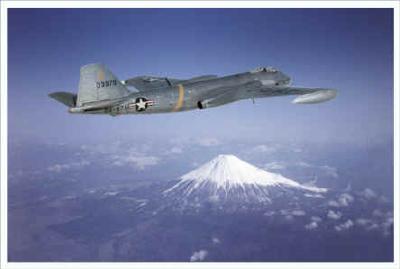
B-57 with Mt. Fuji
(Courtesy Jack Stoob) Jack Stoob of Arcata, California
was a Navigator/Bombadier in the 8th Bomb Squadron (Tactical) from
approximately November 1958 to October 1962. He first arrived TDY to Kunsan in
Dec 58 and had many opportunities to revisit the Kunsan C-pad because of the
monthly rotations circulated between the squadrons.
Jack wrote, "My memory is a bit hazy but actually we were not too bored as I
remember. There were running poker and bridge games going on all the time. I
was a bridge player; at a tenth of a cent a point. An arriving crew would
simply take the place of departing crew members' at either a poker or bridge
table. Sometimes played up to sixteen hours a day." He added, "Also, towards
the end of my tour a nine hole golf course was made available to us, if I
recall correctly."
He wrote, "Our daily routine included going to the officer's club for dinner
and a movie. The movie was often interrupted by a loss of power." He later
wrote that the name of the club was the "Bottom of the Mark." He went on, "I
also recall that the only vegetable available there was lima beans. I still
can't stand them." During this time, the local produce was fertilized with
"night soil" (human waste) and all of local produce was considered unfit for
consumption. As a result, on canned "greens" were authorized.
When asked about his general impressions of Kunsan, he stated, "I don't have
any real positive or negative impressions of the base. We were all in the same
boat and made the best of having to be there. Because of the comradeship of all
there, it didn't seem so bad. Of course, we all would have rather been back
with our famlies but such was not the case. In fact, I had to be evacuated back
from Kunsan to Johnson/Yokota three different times to be there for the birth
of each of our three children. Tough on my wife but such was life at the time."
He added later, "I do recall that early in my tours at Kunsan, we all slept in
buildings near the officer's club. I'll be sending a picture of one in the
future. In the middle of my stint there the sleeping quarters were on the pad
itself. In the same building where the poker and bridge games were on-going.
Near the end of my tour a permanent type barracks building(s) were constructed
and became our sleeping quarters. These were again near the officer's club. I
believe these were built about the same time that
the golf course was built."
(Go to 6175th ABG (1958) for photos of the base that Jack contributed. The photos are great in that
they capture buildings left from the Korean War that would soon be leveled to
make way for modern structures.)

Kunsan AB (K-8) above end-of-runway showing the BOQ area (1963)
(Courtesy Norman Hartman) 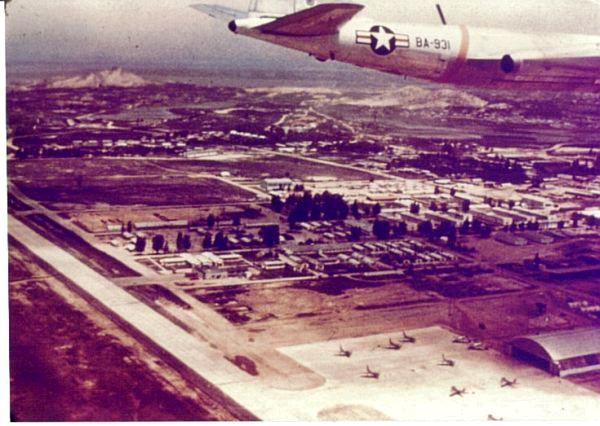
Kunsan AB (K-8) above ROKAF Ramp (lower right); main base (middle); BOQ area (upper left). (1963)
(Courtesy Norman Hartman) 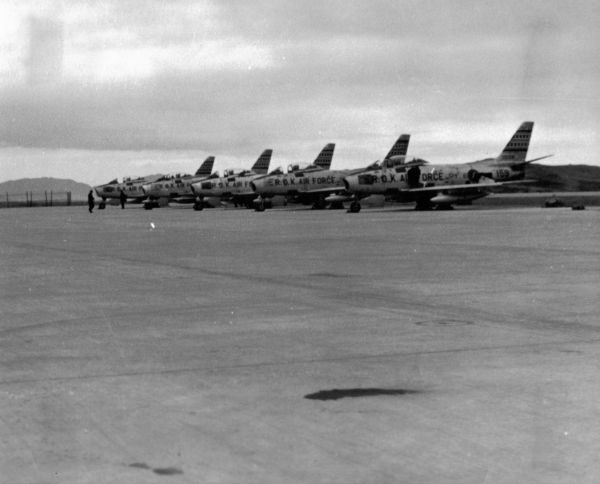
ROKAF F-86s at Kunsan (1963)
(Courtesy Norman Hartman) 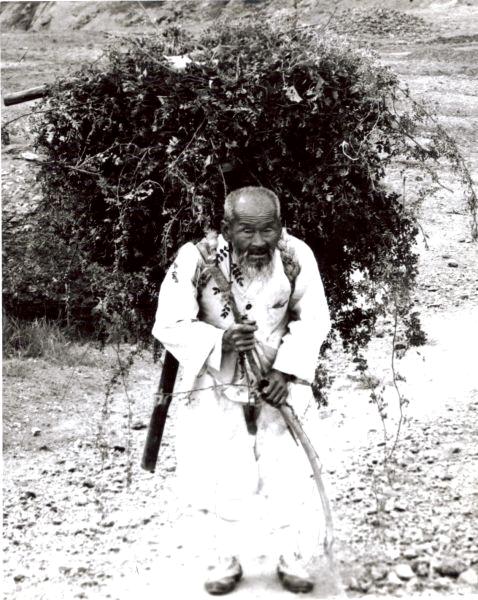
Photo of farmer with A-frame (Choge) outside of Kunsan AB (1963)
(Courtesy Norman Hartman) Norman Hartman said, "The Korean farmer held me up for 5 cigarettes in order to take his photo."

Norman Hartman outside the fence line at the Haje fishing village (1963)
(Courtesy Norman Hartman) Later Norman wrote in Jan 2007, "As far as the flats, we got a day off and checked out a Ford crew cab from the motor pool and just drove around . ... When I was at K-8 the PAD was a total lock down, and you were there for thirty days. Some times if there was no workload you could get permission to explore the rest of the base and surrounding area. We would check out a truck from the motor pool for our local travels. We just happen to be able to drive out to the flats at low tide and we only did this just one time. On this outing is when I took the photo of the local farmer. On this day we also attracted a group of children , ages of 5 - 12 yrs old. As we walked thru the village they ( the children were chanting in a tune of GIGUM !, GIGUMI ! , GIGUM ! ) It took me a while to finally figure out they were wanting gum ! So me like a dumb shit just happen to have a pack of gum on me and figured at least I could make 10 kid's happy, right ! WRONG ! I gave the youngest one a stick of gum and at that instantly the other kids beat the crap out of this poor young kid. That was it , I shut down the welcome wagon and were outta here. On the way back to the truck the older kids were wanting cigarettes, I asked one of them how old he was , he said 12 yrs old ! I told him you are to young to smoke, at that in a true ( THANK YOU FOR SAVING MY ASS FROM THE COMMIES ) he replied F**K YOU G.I.! Upon hearing that we left Dodge City and never went back in two and a half years."

Contingency Pad flightline. Note the double wire fence to side for alert area. Quonset huts in background for maintenance. (1963)
(Courtesy Norman Hartman) Norman wrote, "...this photo I believe is of the" BACK LINE" outside of the PAD. As you stated the huts are maint.to support the activities of the BACK LINE, and a U-2 open air hangar was located there also. The way that the shadow is on the ground tells me the wing tip is pointing WEST and it is around NOON time. The tail of the A/C is pointing south. So the Yellow Sea is to the left, of the left wing tip. The BACK LINE was home of about three B-57's from the 8Th & 13TH BS that were used to keep the flight crew's active. The A/C on the PAD were uploaded and were just waiting for a call. No flight ,except for the real thing. The BACK LINE was also home for some F-100's out of Misawa AFB. GREEN HOUSE IS UNKNOWN TO ME. SORRY !
"When I was there the enlisted quarters were on the south side of the PAD and the Flt. crews quarters for PAD C were just further south from us. Anyone that lived at PAD C knows that the Kero heats always ran out of fuel at 0400 or 0430 and how was going to out wait who, to get more fuel ? Answer ! no one . You laid there waiting to go to the chow hall. I will say one thing,the food at K-8 was the best I ever had while in the service of our country, Wake Islands Chow Hall comes in second.
"Yes , when I was there we did have double fencing with stacks of barb-wire, and at times dogs were in the area. The AP's were squirrely and in one case shot himself, just to get out of Korea and the hot pad. There was a wide red line that you did not walk out of or one of these fall on the sword guys would toast you. The secret word of the day would be Black Bear or it would change daily at times. It could be brown bear, polar bear, grizzly bear I don't know , but you better know what bear it was before you got to your A/C or you are dead.
"I preferred to work at the PAD, to get away from all of the action at Fusa. I wanted to just relax with a nuclear device and smell the roses.
I remember when we were flying over Korea on our way to K-8 on Air America"s C - 46's you could look down from 6 to 8 thousand feet at the ground area and see all the battle damage from years ago, It looked like the Korean War was just over last week.
"When I was there, there was a step mountain ( HILL) called Marine Hill as we called it. and was as I have read in afew articales, and was told , American Airman or other U.S.A. personnal were hung upside down and defiled by the North Korean's.in the hangars that were close by." (SITE NOTE: This is one of the urban legends that has persisted until today. The fact is that the Americans (US Army, 3d Btn 63rd Regiment) departed what was called "Camp Hillenmeyer" in May 1948 and turned the camp over to the Korean Constabulary -- forerunners to the ROK Army. When the North overran Kunsan, there were no Americans -- and no Korean constabulary either. Anyone in power fled south to Mokpo and Pusan.)
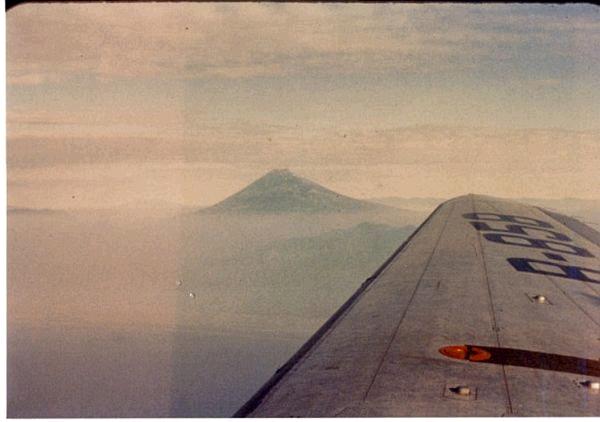
Flight from Kunsan to Tachikawa on Air America C-46 with Mt. Fuji off the wingtip (7 Jun 1963)
(Courtesy Norman Hartman) 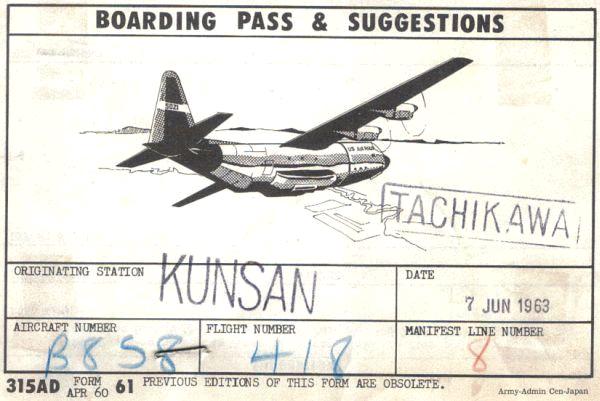
Boarding Pass for Tachikawa from Kunsan for Norman Hartman (7 Jun 1963)
(Courtesy Norman Hartman) Norman Hartman said, "I figured the boarding pass would be of interest. In 61 Air America had the contract to haul are Butts around. It was an adventure in flying those C-46's, one night on the way to K-8 we got caught in a typhoon. We bounced around like a BB in a Pea Can, luckily I got to fly the jump set. The rear of the aircraft smelled like the worse bar I was ever in while in Japan. There is nothing worse then smelling recycled Kerin Beer and Aka Dama Wine." Later he noted, "After all of these years, I just noticed that the a/c number on the boarding pass is the same number that is on the wing of Air America's C-46 enroute from K-8.) (SITE NOTE: In the early 1970s, Kalani O'Sullivan remembers the TDYs to Korea where the troops from Yokota would take along their Akadama wine (much too sweet alcoholic fruit juice) to cut the rot-gut soju that was available in Korea.)
After the End of Nuclear Alert: The rotation continued until April of 1964, when the 3rd BG returned to Yokota
to begin the process of inactivation. According to Baugher site, "This would ordinarily have been the end of the service of the B-57B with the
USAF, with the 3rd BG being inactivated and all its planes being transferred to
the Air National Guard. However, the worsening situation in Indochina led to
orders for the 8th and 13th Bomb Squadrons of the 3rd BG to deploy to Clark AFB
in the Philippines for possible action in Vietnam. As it happened, this move
did not take place until August 5, following the Gulf of Tonkin incident in
which North Vietnamese gunboats clashed with US destroyers."
After the deactivation of the 3rd Bombardment Wing, the nuclear commitment at
Kunsan was continued by F-100s from the 39th Air Division of Misawa AB, Japan
from 1964-1967. It was not until 1968 that 475th TFW Det 1 assumed standing
nuclear alert at Kunsan.
Martin B-57 Canberra:
According to